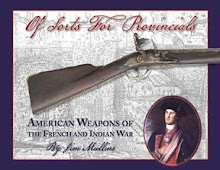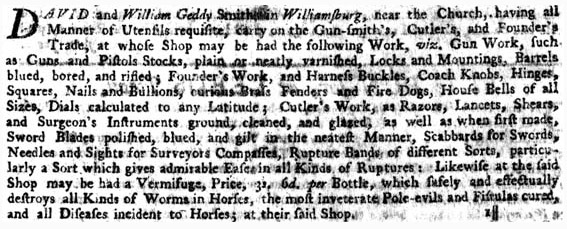A somewhat oddball item pops up every now and then in primary documents- the linen shot bag. Generally speaking, this is encountered as a military issue "make do" item in the absence of the more typical leather pouches for 18th century American soldiers, but there are English sporting treatises that mention a similar item:
Conjectural linen shot bag based on multiple period accounts and the crudely sewn Hutchins pouch.
"Our Shot of sev'ral sorts, half round the Waste, In Ticking semicircularly plac'd," (Pteryplegia London, 1727)
"A leather pouch, or small canvas bag, to carry the shot; with a tin, or other measure..." p9 (A Treatise on English Shooting; by GEORGE EDIE, Gent. London 1772).
Shortages of both cartridge paper and ready made shot bags forced French and Indian War Provincials to utilize such linen pouches.
“The Col. Is desired to collect in Virginia as many Powder horns as can be got, all that can be had from Pensilvania shall be ordered... For Shot Pouches, osnabrug [a course, unbleached and cheap linen] will be bought, with thread to make them one yard will make 8 bags.” (Bouquet to Washington June 13, 1758 George Washington papers p 208).
"I have us'd my best endeavours to get my Men equip'd with Powder Horns and Shott Pouches, and have procur'd 330 of the former, and 339 of the latter; besides the Linnen ones, with which we are compleated." (George Washington to Henry Bouquet, July 3, 1758, two same date ).
Osnabrigs widths are hard to come by, but the intrepid Steve Rayner found the references below:
‘78 yards brown linen at 15d (33 ins wide, nearly)___£4_17s__6d
100 1/2 yards white oznabrig at 10d (28 ins wide)___4__3s__4d
100 yards brown oznabrig at 7 1/4d (27 ins wide)___3_11__0d
24 1/2 yards Russia drab (28 ins wide)_____________1__42__6d...’” p. 130.
Hall, Douglas; “In Miserable Slavery: Thomas Thistlewood in Jamaica, 1750-86.” University of the West Indies Press, Kingston, Jamaica. 1999.
Observations on the Present state of the Linen trade Robt Stephenson, Dublin 1784; an additional hat tip to Steve Rayner
Keeping in mind that osnabrigs in the period were generally around 28 inches wide, it would seem that if using the whole amount for a pouch the beginning fabric dimensions would be around 9 x 14. Similar arrangements seem to have been used by the Revolutionary War 2d Virginia Regiment.
October 12, 1775: “… Each Company is to draw a sufficient Quantity of Dutch or Russia Drilling to provide Each Soldierwith a Shott Pouch with a partition in division in the middle to keep buckshot and bullets separate. Each Soldier to make his own sack and Shot Pouch as near one
General Size Pattern as possible…”
“The Captains in the there Respective Companys are to fix up the Powder horns & Shot Bags. When both are finished & See that proper Belts & Stoppers are Provided, where Shot Bags only are Ready the must be Fixed with Belts & 6: Cartridges of Powder and also Six Bullets Deposited in Each Bag & Dilivered to the Soldiers Respectively.”
(Tartar, Brent, editor. "The Orderly Book of the Second Virginia Regiment, September 27, 1775-April 15, 1776." Virginia Magazine of History and Biography, 85 (April, July 1977), pp. 156-183, 302-336.)
Various notations in the Virginia public store for shot pouches indicate the 2d Va shot bags were made of "Twill" and "Duck" linen. The "belts" are likely fabric straps similar to those sewn to haversacks.
Georgia
Order Book of Samuel Elbert, Colonel and Brigadier General in the Continental Army [2d Georgia Battalion] Headquarters, Fort Howe, 1778 [6? May 1778]
"Commanding
officers of corps are to see that such of their men as are without do
immediately provide themselves with powder-horns and as many have not
the proper means of carrying their cartridges, application must be made
to the Deputy Quarter Master General, for leather or canvas to make pouches for supplying the deficiencies..."
Massachusetts
North Carolina
Enoe Camp Friday May 10th 1771.
The Commanding Officer of each Detachment will send to Mr. Hogen this morning for the Quantity of Ticking, Gartering, Thread and Needles to make shot Bags which they will Immediately get made by the Taylor of their Respective Detachments to be Distributed to their several Corps that wants them.“His Excellency Govt. [sic] Tryon to Johnston & Thackston,
1771_______________________________________________Dr.
May 7. To 1 quire paper______________________________£0__1__4
___11. 674 yd. Bedtyke for Shotbags,
4s. 4d.______________________________£1__7__1
47 yds. Cotton for blankets and
tools, 3s._____________________________7__1__0
6 oz. thread for making Do, 6d__________0__3__0
3 pr. Garters, 10d._____________________0__2__6
5 doz. Vest Buttons for Shot-
bags, 10d.____________________________0__4__2
1 brod. hoe, 5s. 8d.; 1 quire paper,
1s. 6d._______________________________0__7__2
21 yds, osnabs. for hunting-Shirts,
1s. 3d._______________________________1__6__3
2 oz. thr’d, Do, 6d.____________________0__1__0
Cash paid for making Do.______________0__9__0 - 11__1__2
___14. 5 narrow axes, 7s. 6d_________________1_17__6
3__________Do, 6s. 6d.________________0_19__6
3 broad____Do, 7s. 6d._________________1__2__6
1__________Do________________________0__6__8
2 blanketts for the Hospital, 1s. 11d____1__8__0 - 5_14__2
___________________________________________________--------
Rec’d June 20, 1771, the Above Acc’t in full.__________£16_16_10
Johnston & Thackston.” p. 455.
Letter from Jethro Sumner to Horatio Gates
September 15, 1780, Volume 14, Page 616
Camp Near Salisbury, 15th Sepr., 1780.
Sir:
I arriv'd here last even'g, and my encamping ground about half Mile in front of Salisbury, a little to the left of the road lead'g to Charlotte. I saw Colo. Lock; he informes me that he moves to day with the party under his Command towards Charlotte. The Guns, & wagons out of repair, I am geting fix'd.
Cartridge box's. I substitute a pouch of Deer Skin & Canvas and shall be diligent untill provided.
In addition to these intriguing, yet vague primary sources there is a surviving 6.5 x 13 inch linen pouch with Revolutionary War provenance at the New Hampshire Historical Society.
Shot Pouch. Canvas. Said to have been carried by Levi Hutchins (1761-1855) of Concord, NH, at Bunker Hill, 1775; Credit Line: Gift of John B. Hills Object ID: 2005.042.03
Combining the above accounts allows a conjectural reproduction to be made within the fabric allotments stated. The Forbes expedition references give us a material size, but lack further information on carriage, yet Virginians a scant 17 years later are making a divided pouch that may have been very close to the example used by Levi Hutchins.
Thanks to the several folks who have shared info on this topic, in no particular order: Todd Post, Justin Mienert, Steve Rayner, Greg Theberge, and Joel Bohy, apologies if anyone was left out.



.jpg)






